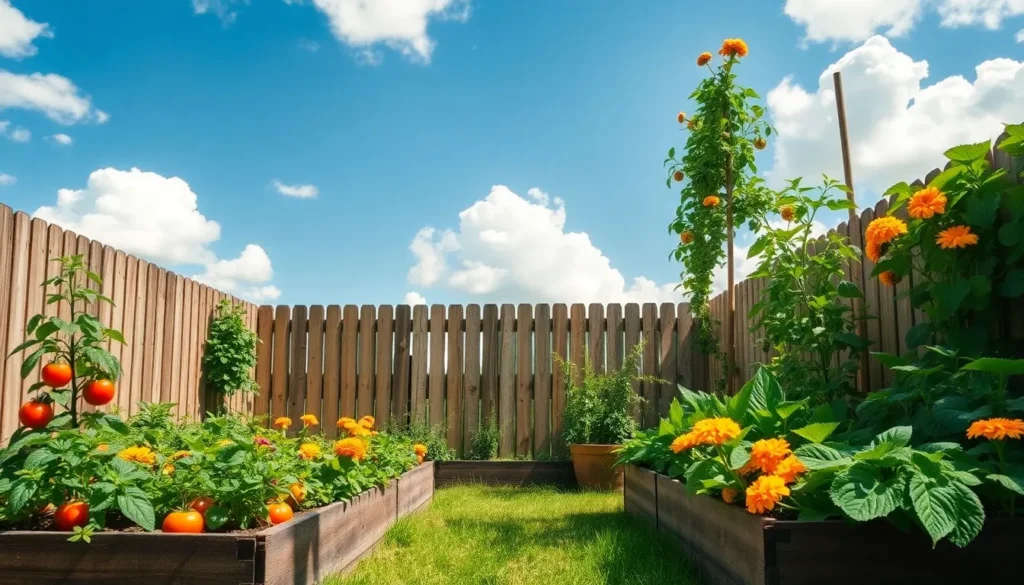Summer is the season when gardens truly come alive, bursting with color and vibrancy that can transform any outdoor space into a personal paradise. Whether you’re just starting your green thumb journey or are a seasoned gardener with years of experience, planning your summer garden can be both thrilling and rewarding, offering endless possibilities for creativity and growth.
In “Garden Planning Tips for Summer,” you’ll discover a treasure trove of practical insights designed to maximize your garden’s potential, ensuring it flourishes under the warm sun. This guide is your ticket to unlocking the secrets of successful garden design, promising lush, thriving plants and bountiful harvests that will fill you with pride and satisfaction.
With each tip, you’ll gain not just knowledge but also the confidence to make informed decisions that bring your garden dreams to life. Let this guide be your trusted companion, turning your summer gardening efforts into a delightful and fruitful endeavor that leaves you basking in the joy of nature’s bounty.
Choose Heat-Tolerant Plant Varieties
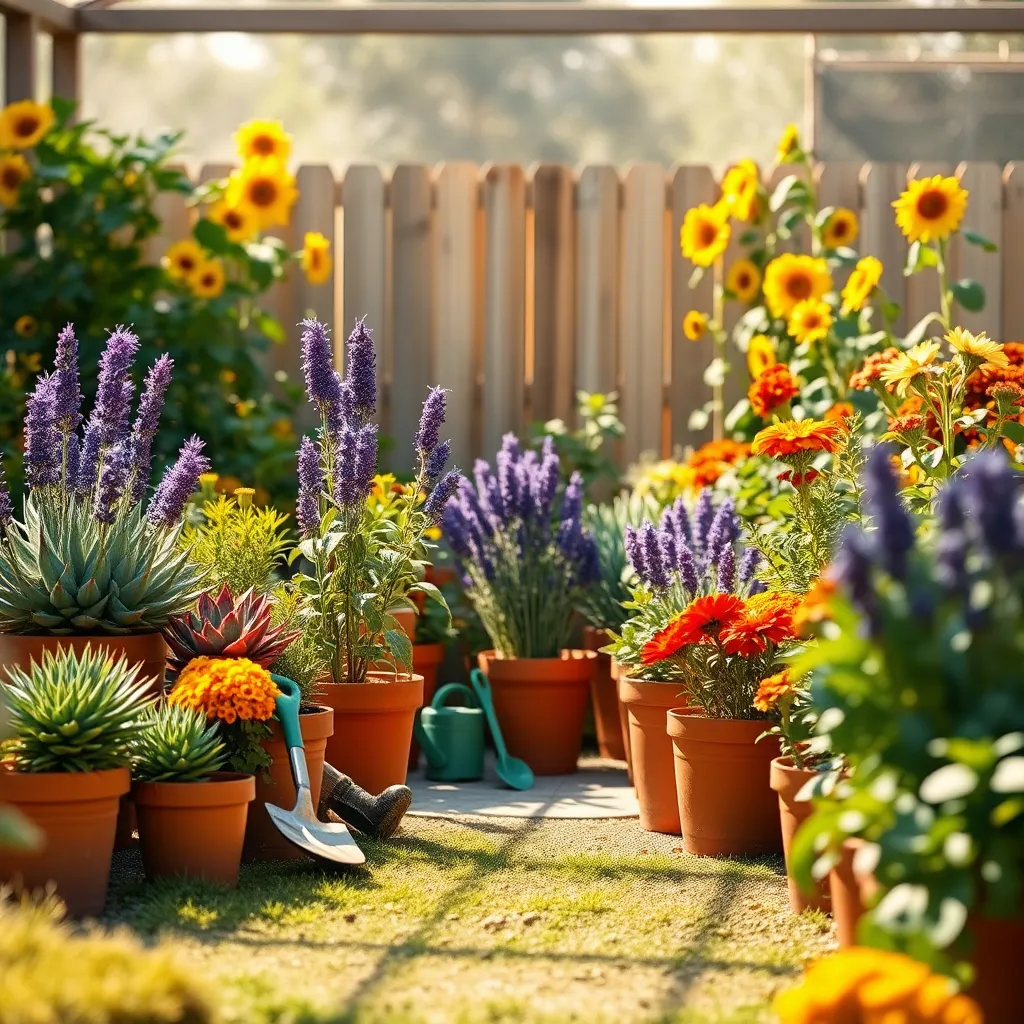
When planning your summer garden, consider choosing heat-tolerant plant varieties to ensure success during the hottest months. Drought-resistant plants like lavender, rosemary, and succulents thrive in high temperatures and require less water, making them ideal choices for conserving resources.
Begin with well-draining soil, as this is crucial for the health of heat-tolerant plants. Amend your garden beds with sand or gravel to improve drainage and prevent root rot, which can occur in poorly drained soils.
Plant care is essential, and watering should be done deeply but infrequently to encourage root growth. During the peak of summer, focus on watering early in the morning or late in the afternoon to minimize evaporation and allow plants to absorb moisture effectively.
Advanced gardeners might explore using mulch to maintain soil moisture and regulate temperature. Organic mulches like straw or bark chips can be layered around plants to reduce water evaporation and keep roots cool, which is crucial during extreme heat.
Schedule Early Morning Watering
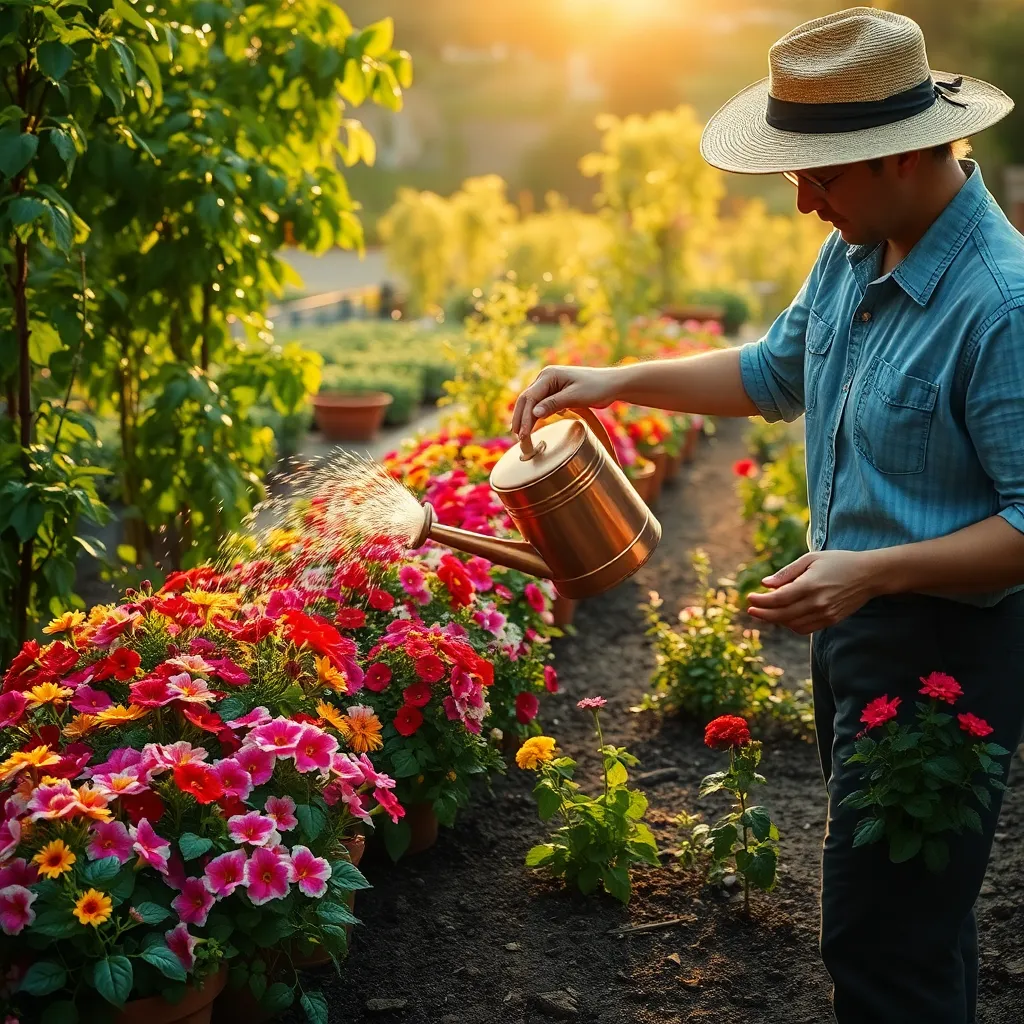
Watering your garden in the early morning is one of the most effective strategies for summer plant care. This practice ensures that plants absorb moisture before the day’s heat intensifies, reducing water loss through evaporation.
Morning watering also helps prevent fungal diseases, which can thrive in the damp conditions created by overnight watering. By allowing foliage to dry out during the day, you minimize the risk of mildew and other moisture-related issues.
For beginners, a simple strategy is to water your plants at the same time each morning, ideally between 6 a.m. and 8 a.m. This routine not only helps establish a habit but also aligns with the natural rhythms of most plants, which are actively absorbing water and nutrients during these cooler morning hours.
Advanced gardeners might consider using drip irrigation systems or soaker hoses, which deliver water directly to the plant roots with minimal wastage. These systems can be set on timers to ensure consistent watering, even on days when you’re too busy to tend to your garden personally.
When watering, ensure the soil is thoroughly moistened to a depth of at least 6 inches for most plants. This encourages deep root growth, making plants more resilient to hot, dry conditions typical of summer.
- Tip for beginners: Use a moisture meter to check soil dampness and avoid overwatering.
- Advanced tip: Mulch your garden beds to retain moisture and keep roots cool.
Apply Mulch to Conserve Moisture
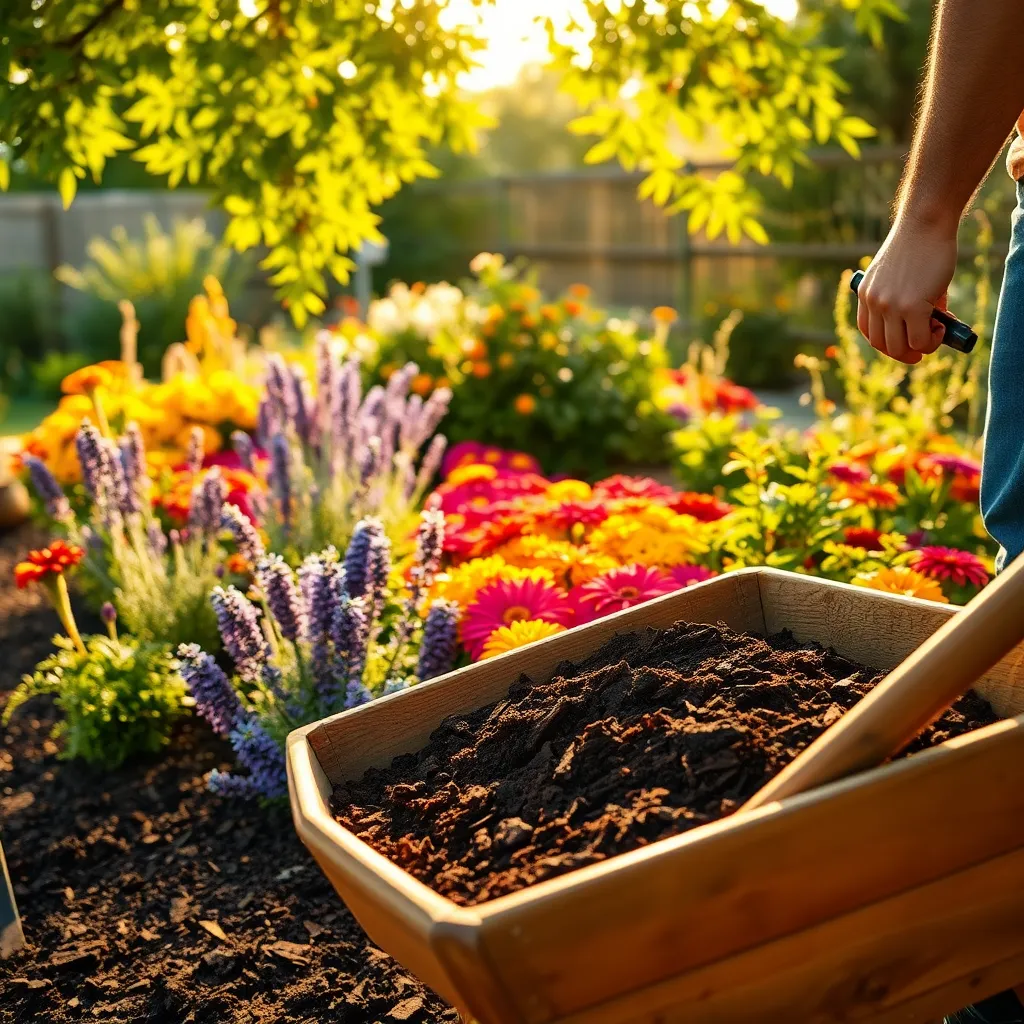
Mulching is a simple yet effective way to conserve moisture in your garden, especially during the hot summer months. By applying a layer of organic material, such as shredded bark or straw, you can significantly reduce evaporation from the soil surface.
Start by choosing the right type of mulch for your plants and climate. For most gardens, a layer of 2 to 3 inches of organic mulch is ideal, as it helps retain moisture and suppress weeds.
Before applying mulch, make sure to water your plants thoroughly. Once the soil is moist, spread the mulch evenly around the base of the plants, keeping it a few inches away from the stems to prevent rot.
Advanced gardeners might consider using composted mulch, which not only conserves moisture but also enriches the soil as it breaks down. This type of mulch is particularly beneficial for heavy feeders like tomatoes and peppers.
Plan for Shade with Tall Plants

One effective way to provide shade in your garden is by planting tall plants strategically. Consider plants like sunflowers, corn, or hollyhocks that can reach impressive heights, offering a natural canopy. These plants are not only functional but also add vertical interest to your garden landscape. Make sure to choose a location that receives enough sunlight in the morning but is somewhat sheltered from harsh afternoon rays.
When planning for shade, ensure the soil is well-draining and rich in organic matter to support tall plant growth. Amend your soil with compost or well-rotted manure to improve its fertility and structure, encouraging strong root systems. Regular watering is crucial, especially during dry spells, to maintain healthy growth. Most tall plants thrive with about an inch of water per week, either from rainfall or supplemental watering.
For beginners, sunflowers are a great choice because they are easy to grow and maintain. Start seeds indoors a few weeks before the last frost, or sow directly into the soil once the ground has warmed. Experienced gardeners might experiment with more exotic tall plants like bamboo, which can also provide a fast-growing privacy screen. Remember to monitor for pests and diseases, which can be more prevalent in dense plantings.
Advanced gardeners may opt to create a multi-layered shade garden by combining tall plants with mid-height and ground-cover species. This approach not only maximizes shade but also enhances biodiversity and visual appeal. Use companion planting techniques to pair species that benefit each other, such as planting corn with beans and squash. By doing so, you create a self-sustaining mini-ecosystem that thrives even in challenging summer conditions.
Incorporate Drought-Resistant Groundcovers
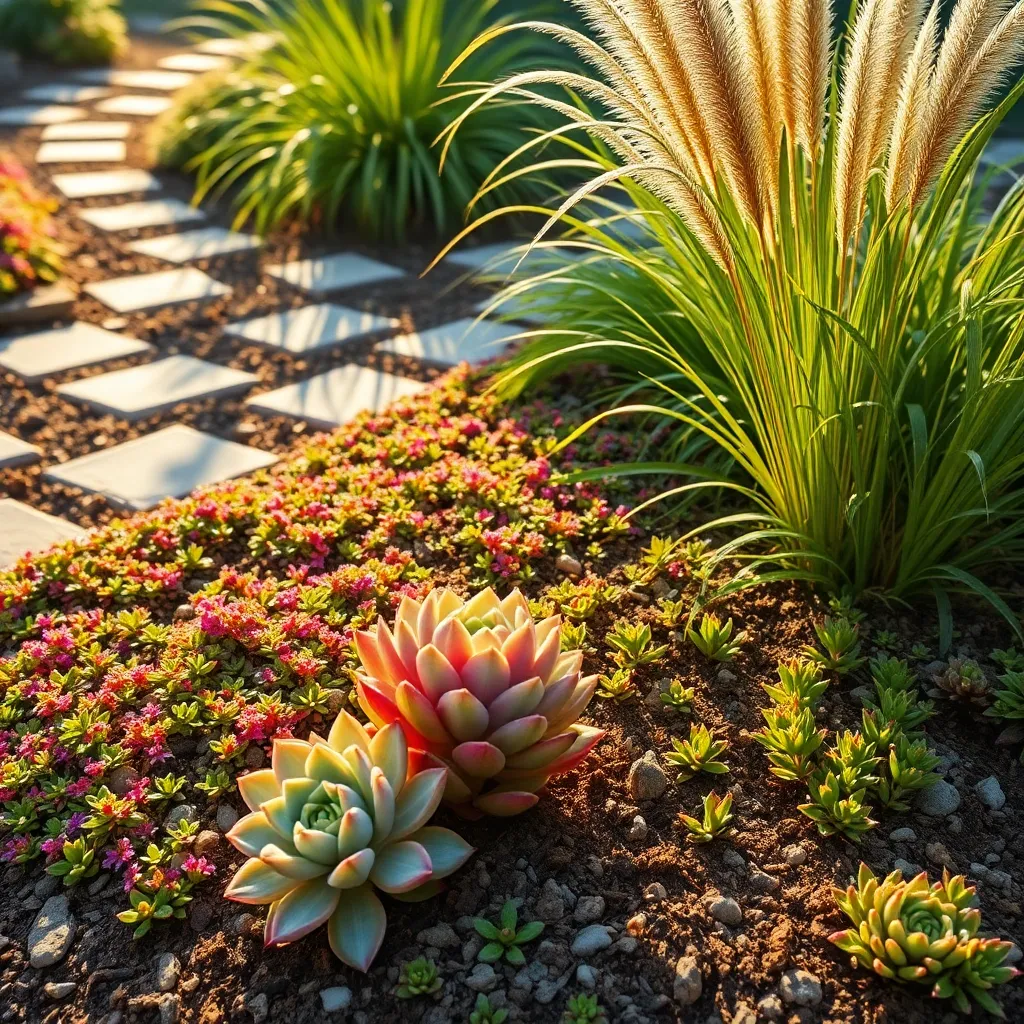
Transforming your garden with drought-resistant groundcovers not only conserves water but also minimizes maintenance. Consider using plants like sedums and creeping thyme, which are known for their resilience and aesthetic appeal.
Groundcovers such as these thrive in various soil types, though they prefer well-drained conditions. Before planting, it’s beneficial to amend your soil with a bit of sand or gravel to improve drainage and support healthy growth.
Watering is minimal once these plants are established, making them perfect for busy gardeners. Initially, ensure they receive regular water until they root well, then you can reduce the frequency to about once a week during dry spells.
For beginners, start with a small area to gain confidence. More experienced gardeners might experiment with combining different species for a mosaic-like effect that provides visual interest and biodiversity.
Conclusion: Growing Success with These Plants
In exploring the art of garden planning, we unearthed five key relationship concepts that can enrich your personal connections this summer. First, we discovered the importance of nurturing your relationships, much like tending to a garden, ensuring they grow with proper care and attention. Second, we emphasized the value of communication, akin to understanding your soil, to cultivate a thriving environment. Third, we discussed the significance of setting boundaries, paralleling the need for strategic garden planning to avoid overcrowding. Fourth, we highlighted the power of shared goals, similar to planting in harmony, fostering mutual growth. Lastly, we explored the resilience needed to weather challenges together, just as a garden withstands seasonal changes.
As an actionable next step, take a moment today to engage in a heartfelt conversation with a loved one, setting the stage for a flourishing relationship. Remember, success in relationships is a journey, not a destination, and this article can be your trusty guide. Bookmark it now to revisit these insights whenever you need a gentle reminder.
By planting seeds of love and understanding, you’re paving the way for a future filled with relationship success. Let this be the summer where your connections blossom.

